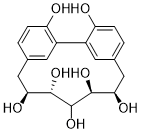Giffonin PCAS# 1830306-93-8 |

Quality Control & MSDS
Package In Stock
Number of papers citing our products

| Cas No. | 1830306-93-8 | SDF | Download SDF |
| PubChem ID | N/A | Appearance | Powder |
| Formula | C19H22O7 | M.Wt | 362.4 |
| Type of Compound | Phenols | Storage | Desiccate at -20°C |
| Solubility | Soluble in Chloroform,Dichloromethane,Ethyl Acetate,DMSO,Acetone,etc. | ||
| General tips | For obtaining a higher solubility , please warm the tube at 37 ℃ and shake it in the ultrasonic bath for a while.Stock solution can be stored below -20℃ for several months. We recommend that you prepare and use the solution on the same day. However, if the test schedule requires, the stock solutions can be prepared in advance, and the stock solution must be sealed and stored below -20℃. In general, the stock solution can be kept for several months. Before use, we recommend that you leave the vial at room temperature for at least an hour before opening it. |
||
| About Packaging | 1. The packaging of the product may be reversed during transportation, cause the high purity compounds to adhere to the neck or cap of the vial.Take the vail out of its packaging and shake gently until the compounds fall to the bottom of the vial. 2. For liquid products, please centrifuge at 500xg to gather the liquid to the bottom of the vial. 3. Try to avoid loss or contamination during the experiment. |
||
| Shipping Condition | Packaging according to customer requirements(5mg, 10mg, 20mg and more). Ship via FedEx, DHL, UPS, EMS or other couriers with RT, or blue ice upon request. | ||

Giffonin P Dilution Calculator

Giffonin P Molarity Calculator
| 1 mg | 5 mg | 10 mg | 20 mg | 25 mg | |
| 1 mM | 2.7594 mL | 13.7969 mL | 27.5938 mL | 55.1876 mL | 68.9845 mL |
| 5 mM | 0.5519 mL | 2.7594 mL | 5.5188 mL | 11.0375 mL | 13.7969 mL |
| 10 mM | 0.2759 mL | 1.3797 mL | 2.7594 mL | 5.5188 mL | 6.8985 mL |
| 50 mM | 0.0552 mL | 0.2759 mL | 0.5519 mL | 1.1038 mL | 1.3797 mL |
| 100 mM | 0.0276 mL | 0.138 mL | 0.2759 mL | 0.5519 mL | 0.6898 mL |
| * Note: If you are in the process of experiment, it's necessary to make the dilution ratios of the samples. The dilution data above is only for reference. Normally, it's can get a better solubility within lower of Concentrations. | |||||

Calcutta University

University of Minnesota

University of Maryland School of Medicine

University of Illinois at Chicago

The Ohio State University

University of Zurich

Harvard University

Colorado State University

Auburn University

Yale University

Worcester Polytechnic Institute

Washington State University

Stanford University

University of Leipzig

Universidade da Beira Interior

The Institute of Cancer Research

Heidelberg University

University of Amsterdam

University of Auckland

TsingHua University

The University of Michigan

Miami University

DRURY University

Jilin University

Fudan University

Wuhan University

Sun Yat-sen University

Universite de Paris

Deemed University

Auckland University

The University of Tokyo

Korea University
- Dicliripariside A
Catalog No.:BCN9320
CAS No.:491613-65-1
- Jinflexin D
Catalog No.:BCN9319
CAS No.:2055155-78-5
- 10-Hydroxyligstroside
Catalog No.:BCN9318
CAS No.:35897-94-0
- 3-epi-Isocucurbitacin B
Catalog No.:BCN9317
CAS No.:89647-62-1
- Flazin
Catalog No.:BCN9316
CAS No.:100041-05-2
- 10-Hydroxymajoroside
Catalog No.:BCN9315
CAS No.:259753-12-3
- Aspyridone A
Catalog No.:BCN9314
CAS No.:935863-26-6
- 2,3-Dimethoxyxanthone
Catalog No.:BCN9313
CAS No.:42833-49-8
- Hydroxytyrosol 4-O-glucoside
Catalog No.:BCN9312
CAS No.:54695-80-6
- 2,5,2'-Trihydroxy-4-methoxybenzophenone
Catalog No.:BCN9311
CAS No.:202463-52-3
- Creoside III
Catalog No.:BCN9310
CAS No.:1038602-12-8
- Juncatrin A
Catalog No.:BCN9309
CAS No.:2265925-12-8
- Hymexelsin
Catalog No.:BCN9322
CAS No.:117842-09-8
- Leeaoside
Catalog No.:BCN9323
CAS No.:1015063-56-5
- Phoyunnanin E
Catalog No.:BCN9324
CAS No.:886747-60-0
- Icterogenin
Catalog No.:BCN9325
CAS No.:561-47-7
- 4a-Demethoxysampsone B
Catalog No.:BCN9326
CAS No.:1292798-98-1
- Cucurbitacin A 2-O-β-D-glucopyranoside
Catalog No.:BCN9327
CAS No.:1135141-76-2
- Lantanilic acid
Catalog No.:BCN9328
CAS No.:60657-41-2
- Methyl lucidenate E2
Catalog No.:BCN9329
CAS No.:98665-12-4
- Hancokinol
Catalog No.:BCN9330
CAS No.:132294-77-0
- 7β-Hydroxycucurbitacin B
Catalog No.:BCN9331
CAS No.:1135141-79-5
- 3α,30-Diacetoxy-12α-hydroxy-23-oxoeupha-7,24-dien-21,16β-olid-28-oic acid 28-O-β-D-glucopyranosyl ester
Catalog No.:BCN9332
CAS No.:215160-96-6
- Sampsone B
Catalog No.:BCN9333
CAS No.:1309125-17-4
New Taste-Active 3-( O-beta-d-Glucosyl)-2-oxoindole-3-acetic Acids and Diarylheptanoids in Cimiciato-Infected Hazelnuts.[Pubmed:29649863]
J Agric Food Chem. 2018 May 9;66(18):4660-4673.
Activity-guided fractionation in combination with sensory analytics, LC-TOF-MS, and 1D/2D-NMR spectroscopy enabled the identification of the bitter tasting diarylheptanoids asadanin, Giffonin P, and the previously not reported ( E)-7,9,10,13-tetrahydroxy-1,7-bis(2-hydroxyphenyl)hept-9-en-11-one and 4,12,16-trihydroxy-2-oxatricyclo[13.3.1.1(3,7)]-nonadeca-1(18),3,5,7(20),8,15,17- heptaen as well as the yet unknown astringent compounds 2-(3-hydroxy-2-oxoindolin-3-yl) acetic acid 3- O-6'-galactopyranosyl-2''-(2''oxoindolin-3''yl) acetate and 3-( O-beta-d-glycosyl) dioxindole-3-acetic acid in Cimiciato-infected hazelnuts exhibiting a bitter off-taste. Quantitative LC-MS/MS studies, followed by dose/activity considerations confirmed for the first time asadanin to be the key contributor to the bitter taste of Cimiciato-infected hazelnuts. Furthermore, quantitative studies demonstrated that neither the physical damage alone nor a general microbial infection is able to initiate a stress-induced asadanin generation, but most likely either specific Cimiciato-specific microorganisms associated with the bugs or specific chemical stimulants in the bugs' saliva is the cause triggering asadanin biosynthesis. Finally, also germination was found for the first time to activate diarylheptanoid biosynthesis, resulting in higher contents of bitter tasting phytochemicals and development of the bitter off-taste.


